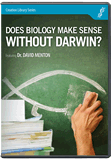
Chapter 31
What About Bacteria?
If God finished creation in six days and declared it “very good,” where did disease-causing designs come from?
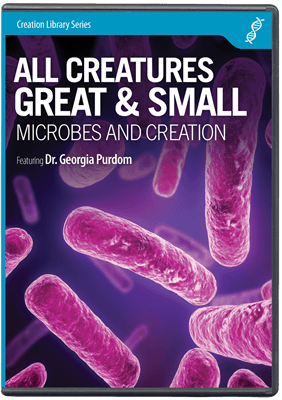
This DVD uses a creationist perspective to help us understand God’s original design and purpose for microbes and how various genetic mechanisms since the Fall have led to bacteria that cause disease.
When my children were toddlers, it seemed to my wife and me that they were always sniffling or coughing, or fighting off a cold or the flu. Many a night was spent rocking a feverish child to sleep. The two of us viewed with fear such ordinary places as the church nursery, seeing it as a breeding ground for infections.
My wife and I count our blessings, however, that our long nights were the only hardship we faced. Before the development of antibiotics and vaccines, infections were a leading cause of death among children. Most families lost at least one child to scarlet fever, diphtheria, pneumonia, measles, or smallpox.
Doctors now know that these maladies are caused by bacteria or viruses (collectively known as microbes).1 As scientists continue to learn more about microbes, they are discovering that microbes employ intricate mechanisms to attack the human body. This raises a question: If God finished creation in six days and declared it “very good,” where did these disease-causing designs come from?
Finding the answer has great potential to help mankind. A better understanding of God’s original purpose for microbes could help scientists see how they have changed and to find revolutionary new ways to treat infectious diseases.
Based on the creation account in Genesis, it appears that God originally made microbes to perform only beneficial functions. If so, one would expect many present-day bacteria to continue to perform their “very good” functions. Creation biologists predicted this and have documented examples.2
The Matrix
Imagine a futuristic city where vehicles are run by highly efficient acid-powered motors that produce little or no pollution. On the way home, your vehicle attaches itself to an airborne mega-transport ship, studded with hundreds of other vehicles. With the combined power of the multiple motors—complete with propellers—the mega-transport travels smoothly through rough weather and treacherous conditions to your home.
After detaching from the ship, you park in your driveway, which senses your car’s dimensions and molds a raised platform to fit the car’s shape, locking it securely 20 feet off the ground.
Imagine that as you’re sleeping an airborne probe flies over your neighborhood and attaches to your home and car, inserting new instructions to update the operating software.
Whenever any cars in the city get the least bit outdated, tiny vehicles prowling the city track them down, attack them, and dismantle the parts. Then, using the old parts, each tiny vehicle can transform itself into a shiny new car, ready and waiting for you in the morning.

Escherichia coli (E. coli) is a bacterium commonly found in the lower intestine. Most E. coli strains are harmless and can produce vitamin K2 or prevent harmful bacteria from successfully invading the intestine. Picture copyright of Rocky Mountain Laboratories.
Your Gut Is a Thriving City
Futuristic city? Not really. These are just some of the things that bacteria do every day in our digestive systems. In fact, the human digestive system is the most densely populated ecosystem on Earth, with hundreds of species of bacteria, yeast, and viruses interacting daily in this environment.3
Each species of bacteria is present in such high numbers that the total population is in the trillions. In fact, if we consider all the bacteria in the human body, there are 10 for every human cell. This means that, by sheer numbers alone, you are more bacteria than human! In the intestines, good bacteria provide nutrients, break down waste, and act as an immune system that prevents harmful bacteria from infecting our body. In fact, the human digestive system may need bacteria to be present before it can develop properly after birth.4 Similar to the vehicles in the futuristic city above, many bacteria have elaborately designed mechanisms to move around in this dynamic, ever-changing environment. It is as though they were created to live there.
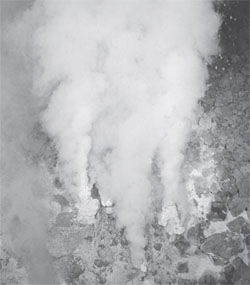
Seafloor vents—On the seafloor are vents where superheated water spews toxic chemicals into the ocean. Numerous microbes, uniquely designed to withstand the extreme heat, feed on these minerals. They are the main food source for whole communities of organisms.
Microbes, Microbes, Everywhere
Microbes are found not only in the human body but also in every environment on Earth, from high in the atmosphere to deep below the earth’s surface, where they survive by eating things like oil and rocks. Microbes thrive in boiling hot springs, ice and snow, the dry heat of deserts, acids, high salt concentrations, rubber stoppers in bottles, and even hand soap.
Microbes Are Our Friends
While some microbes do cause disease, most do not. About 5,000 species of bacteria have been identified, but only about eight percent cause disease. While most species of disease-causing bacteria have been carefully identified (for obvious reasons), microbiologists estimate that 10 million other species of unidentified bacteria fill the earth. So the disease-causing species may account for only a tiny fraction of all bacterial species.
If most bacteria and other microbes don’t cause disease, just what are they doing? Since the Bible states that God made everything “very good” at creation, creationists would expect to see the microbes’ very good function all around us, on a grand scale.

Antarctic lake ice—Antarctica is home to numerous microbes. In fact, some organisms survive in water two miles below the continental ice sheet, where no air or light reaches. The frigid water is seven times saltier than the ocean, and the temperature falls below 14°F (-10°C).
Quite remarkably we find that microbes play a vital role in distributing and recycling nutrients all over the planet.5 For example, every living thing needs carbon, oxygen, hydrogen, and nitrogen. Many bacteria specialize in recycling these nutrients through the air, water, and land. This crucial process, called biogeochemical cycling, takes place on an unimaginably huge scale (see “The Necessary Matrix of Bacteria”).
Many, many microbes must work in concert to perform this cycling. Once thought to be a sterile wasteland, the deep earth appears to be a major chemical factory, filled with a mass of bacteria that could be greater than the combined mass of all plants and animals living on the surface.
Without the millions of different microbes, the earth’s vast resources would be useless to us. We need their help to get the necessary chemicals out of the earth and into our bodies. We couldn’t even eat steak or salad without bacteria in our stomach to help break food down. So every day, throughout the day, God displays His infinite love and wisdom, caring for every living thing even at the lowest, molecular level.
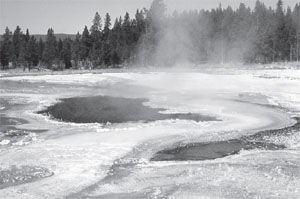
Acidic hot springs—Hot springs, such as those in Yellowstone National Park, are home to a spectrum of microbes. They can survive temperatures well above 100°F (35°C) and acids potent enough to dissolve iron.
Microbes play a vital role in distributing and recycling nutrients for living things all over the planet.
Consider just one example—nitrogen recycling. Unlike the oxygen in the atmosphere, the nitrogen that we breathe is basically useless to humans and animals. The chemical bonds are just too strong. But a few bacteria and other microbes have the incredible ability to break the bonds of nitrogen and make it useful to living things.
In fact, many plants have specialized organs attached to their roots that house these nitrogen-loving bacteria. This relationship between plants and bacteria is a common phenomenon called mutualism, a form of symbiosis. It is a relationship whereby each partner benefits by living with the other partner.
Nothing Lives Alone
All creatures on Earth live in symbiotic partnerships, including lowly single-celled pond-dwelling organisms. It appears that the Creator wants us to “clearly see” in these pervasive symbiotic relationships how much we depend on others—and ultimately Him—for life. From the very beginning of time, all the different creatures on Earth had to be alive and working together, and we continue to depend on them (and God) for a healthy life.
So what are all these symbiotic microbes doing? Creationists have noted several major things, such as providing nutrition and influencing reproduction of insects. Let’s consider just a couple of other interesting examples from the animal kingdom.
The Necessary Matrix of Bacteria
Bacteria are almost everywhere, busily sustaining life in ways we rarely see or appreciate. God designed bacteria, in many cases, to make inaccessible atoms available to us. A matrix of bacteria works around the clock to provide many vital ingredients of life.

Oxygen-Producing: Cyanobacteria in the oceans break apart the bonds of carbon dioxide, making oxygen available to living things. Perhaps the most abundant creature on Earth, these microbes may release more oxygen than all green plants combined.
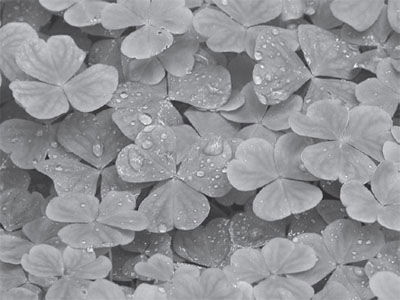
Nitrogen-Fixing: Our atmosphere is rich in nitrogen, but the majority is unusable because the atomic bond is too strong to break. The bacteria in the genus Rhizobium, which live in and around plants, fix the nitrogen, making it usable to the plants. Most animals get their nitrogen indirectly from these nitrogen-fixing bacteria.

Carbon-Recycling: Many different bacteria recycle carbon, an essential building block of life. One specific duty is to break down dead plant matter and sea creatures. Without these bacteria, our forests would be choked with branches and leaves, and our oceans littered with exoskeletons

Rock-Eating: Many essential nutrients in the soil come from weathered rocks. A group of bacteria, known as lithotrophs, actually speed up this process by feeding on the minerals within the rocks. As these rocks break down, they enrich the soil, thus benefitting the plants that we eat.
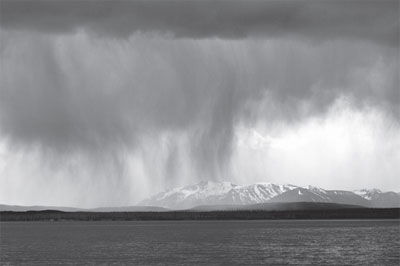
Rain-Making: Some bacteria even help to make it rain! This recent discovery supports the biomatrix concept that microbes assist life cycles throughout our world.
Defending Plants and Animals
Microbes are also involved in defending plants and animals against attack by other organisms. For example, consider that in the early 1900s a fungus almost wiped out the majestic American chestnut tree. A few trees survived the blight, however, and they were found to possess a virus that modified the blight, causing the fungus to be less potent. Now scientists are breeding resistant chestnut trees that could once again grace American forests.
It seems likely that God originally designed certain viruses as part of the immune system of plants.
Bioluminescence
Another interesting partnership is the bioluminescent (light-producing) bacteria that grow inside special light organs in creatures such as the Hawaiian bobtail squid.6 The bioluminescence may help protect the squid against predators that swim under them at night. Perhaps the glowing squid appears as moonlight to predators lurking below, or perhaps the squid uses the light to see its way through murky water or at night. Whatever the bacteria’s function, recent studies show that bioluminescent bacteria play an important role in the great depths of the ocean.
These are just a couple of the interesting symbiotic partnerships of bacteria
and other microbes. Their amazing abundance and their life-supporting functions
suggest that the Creator—our “living God
” (Psalm 84:2)—made microbes to form
a massive, life-sustaining, life-promoting biomatrix on Earth.
When you look closely at the microbial world, two major themes are inescapable. One is that our living God intended to “fill the earth” with life, evidenced by the pervasive, life-sustaining biomatrix of microbes, animals, and humans. Second is the Creator’s emphasis on relationships. A vast multitude of living things interact with each other as God designed it to be and as He sustains it.
For in Him we live and move and have our being(Acts 17:28).
Good Designs Gone Bad
So what mechanism caused some of these “very good” microbes to go bad? Did God directly modify them, or did they change over time? At least three possible changes may have occurred, or a combination of all three:
- Displacement. Microbes were originally designed to perform beneficial functions in restricted places, but after the Fall they spread to other places and began to cause disruption and disease.
- Modification. Microbes were physically modified to become pathogenic (disease-causing).7
- Uncontrolled growth. Their numbers were designed to remain within safe ranges, but now they fluctuate, causing either under- or over-population that results in disease and disruption of a once-balanced system.
Scripture hints at examples of helpful creations that have gone bad, such as thorns and thistles. Yeast is an example of a good thing that becomes invasive and harmful when it spreads too rapidly (see 1 Corinthians 5:6–8). In fact, yeast can cause severe infection, such as thrush and candidiasis in humans. Let’s consider examples of other common disease-causing microbes.
Displaced Cholera
It seems that many microbes once had a good purpose but have changed as a result of the Fall and now cause disease.
Cholera is a severe intestinal illness that humans get from contaminated water or food. It leads to severe diarrhea, shock, and even death. In its most virulent form, it can kill within three hours of infection. Cholera is caused by the bacterium Vibrio cholera, which produces a variety of toxins. Interestingly, most species related to Vibrio cholera grow harmlessly on the surface of practically all shelled ocean creatures and some fish. There they perform a valuable task: breaking down chitin, the main component of the hard outside shell, or exoskeleton, of crabs, shrimp, lobsters, and many other sea creatures. Without their help, oceans and beaches would be littered with billions of shells. The breakdown of chitin also returns precious nutrients like carbon and nitrogen back to the ocean.
Even more fascinating, some of the cholera components that are toxic to the human intestines are used to break down chitin. So creationists hypothesize that Vibrio cholera originally broke down chitin in the ocean, but after Adam’s Fall, God allowed them to spread beyond their proper place.
Disease-causing versions of Vibrio cholera may also have been genetically modified after the Fall. We have discovered that they have some extra DNA, apparently inserted by viruses, which allows the bacteria to produce toxin. Other types of cholera lack this DNA and are typically nontoxic.
Modified E. Coli
Another bacterium that appears to be modified is Escherichia coli. Normally, each person carries millions of harmless E. coli in his or her intestines, where it helps keep the digestive track running smoothly. E. coli is so intimately associated with the human body that health departments check for it when they want to confirm human activity in or near a waterway. Unfortunately, viruses appear to have infected some E. coli and introduced their own DNA into the E. coli’s DNA. For instance, one strain of E. coli8 has an extra piece of DNA that produces lethal toxins. If you remove the offending DNA, you remove much of this bacterium’s disease-causing potential.
But why would E. coli carry a toxin in the first place? What was this toxin created to do? No one can say for sure, but we do know that this strain of E. coli lives harmlessly in the gut of farm animals, where it has been shown to help protect against cancer-causing viruses.9 So creationists hypothesize that the disease-causing abilities of this strain may have been acquired by the displacement or modification of a harmless E. coli.
In recent years medical researchers have also discovered that beneficial E. coli may protect our intestines from disease-causing bacteria. In fact, some physicians are administering a strain of E. coli to “at-risk” newborns to shield the babies from diarrhea-causing bacteria.10
A Deadly Change
Most strains of E. Coli bacteria are harmless. The strain that commonly causes lethal food poisoning contains an extra piece of DNA, not found in the harmless strains, which produces the deadly toxins. Creationists hypothesize that this strain may have acquired its disease-causing ability from viruses, which modified the bacteria’s original DNA.
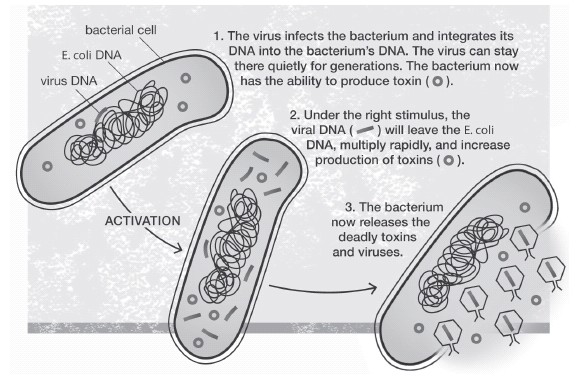
New Treatment Ideas
This concept, that intestinal health depends on the presence of beneficial bacteria, forms the basis of an entirely new area of medicine called probiotics. Several over-the-counter products are now available that may help boost beneficial bacteria populations in the gut.
Also, a new theory in medicine called the hygiene hypothesis is based on this idea. The proposal is that humans should be exposed to microbes early in life; and if they are not, a variety of disease conditions may result, including asthma, multiple sclerosis, and colitis.
Scripture clearly shows that plants, which now have thorns and thistles as a result of the Fall, once had only good functions. Considering this example, Christians can begin to imagine how all of God’s creatures once had beneficial roles; and perhaps, in some cases, this knowledge can be used to fight disease.
At least one creation researcher is already investigating such ideas and is proposing ways in which certain bacteria can be used to fight cancer.11 This kind of medical treatment represents a very promising and exciting new area of research. Best of all, it flows from our understanding of God’s beneficent creation, which He graciously allows to persist in a fallen world.
The New Answers Book 3
Do you have answers to the big questions about the Christian faith, evolution, creation, and the biblical worldview? Now you get the important information you need regarding the existence of God, global warming and climate change, cloning and stem cells, human and chimp DNA, the importance of Mount St. Helens, and more.
Read Online Buy BookFootnotes
- Viruses are considered to be a separate category, but for the sake of this discussion we will include them as microbes.
- Only about eight percent of the identified bacteria cause disease. For past predictions by creation biologists, see A. Gillen, The Genesis of Germs (Green Forest, AR: Master Books, 2007); J. Francis, “The Role of Virulence Factors in the Establishment of Beneficial Ecological Relationships of Vibrio cholera and Vibrio fischeri,” Occasional Papers of the BSG 8 (2006); Francis and Wood, “The CT Toxin of Vibrio cholera, Its Structure, Function, and Origin,” Occasional Papers of the BSG 11 (2008); and J. Francis and T. Wood, Stadium Integrale 16 (2009): 88, “Cholera Toxin and the Origin of Cholera Disease.”
- Steve Gill et al., “Metagenomic Analysis of the Human Distal Gut Microbiome,” Science 312 (2006): 1355–1359.
- Recent research has also shown that the heart is decreased in size in animals that develop without intestinal bacteria. Peter Turnbaugh et al., “The Human Microbiome Project,” Nature 449 (2007): 804–810.
- See J.W. Francis, “The Organosubstrate of Life: A Creationist Perspective of Microbes and Viruses,” Proceedings of the Fifth International Conference on Creationism, 2003.
- E.G. Ruby, “Lessons from a Cooperative Bacterial-Animal Association: The Vibrio Fischeri- Euprymna Scolopes Light Organ Symbiosis,” Annual Review of Microbiology 50 (1996): 591–624.
- It is not yet known whether these modifications occurred directly by God or indirectly by the changed environment of the cursed post-Fall world.
- A bacterial strain is like a subspecies. E. coli is one species, but it has many subspecies or strains, which differ just slightly from one another. The harmless strain of E. coli that is found in the gut of farm animals but is toxic in humans is labeled E. coli O157:H7. The strain administered to newborns is E. coli AO 34/86.
- C. Zimmer, Microcosm: E. coli and the New Science of Life (New York, NY: Pantheon, 2008).
- See reference 8.
- Luke Kim, “Bacterial Attenuation and Its Link to Innate Oncolytic Potention,” Answers Research Journal 1 (2008): 117–122.
Recommended Resources

Answers in Genesis is an apologetics ministry, dedicated to helping Christians defend their faith and proclaim the good news of Jesus Christ.
- Customer Service 800.778.3390
- © 2024 Answers in Genesis





